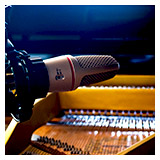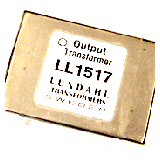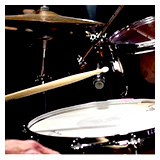 | US$2480 | €2260 | £1940 |
| US$2480 | €2260 | £1940 |


the MA2.2B is available with a silver-grey or black face plate
So what is new in the MA2.2B:
![]() Functions are now controlled with illuminated push button switches with "clickless" operation, no more thumps on the output.
Functions are now controlled with illuminated push button switches with "clickless" operation, no more thumps on the output.
![]() The gain pot has been replaced with a calibrated 24 position Elma switch for accurate stereo matching between channels.
The gain pot has been replaced with a calibrated 24 position Elma switch for accurate stereo matching between channels.
![]() We have added a useful 19 segment peak output level meter.
We have added a useful 19 segment peak output level meter.
![]() But, the original audio and power supply design of the MA-2.2 has been retained.
But, the original audio and power supply design of the MA-2.2 has been retained.
 Designed to provide transparent amplification to reveal the true source, they do not come any better than this. If you wish to record your sounds with the utmost warmth and clarity possible, you have found the tool for the job. And it's not just us blowing our trumpet here, it's what hundreds of users have told us over the years since we began building the very first MA-2 back in 1993, (re-vamped as the MA2.2 in 1999). The MA2.2B is a very high end product designed without low price as a primary goal, so it is an investment for sure. However, the high standard of workmanship and meticulously engineered construction means it will last a life time - something our users who purchased 20 years ago now experience.
Designed to provide transparent amplification to reveal the true source, they do not come any better than this. If you wish to record your sounds with the utmost warmth and clarity possible, you have found the tool for the job. And it's not just us blowing our trumpet here, it's what hundreds of users have told us over the years since we began building the very first MA-2 back in 1993, (re-vamped as the MA2.2 in 1999). The MA2.2B is a very high end product designed without low price as a primary goal, so it is an investment for sure. However, the high standard of workmanship and meticulously engineered construction means it will last a life time - something our users who purchased 20 years ago now experience.
The circuitry used in the MA-2.2B preamp was developed by Buzz Audio designer Tim Farrant in the 1990's and was dubbed "True Class A". The resulting BE40 series of amplifiers exhibit very wide frequency response (into the mega-hertz ) and ultra fast slew rates (140V/uS) even at 60dB of gain. These attributes, plus the inherently low distortion provide the exceptionally pure top end sound of the MA-2.2B. In addition, the over engineered power supply design with localized Class A regulators for each amplifier stage supplies the grunt needed for an authoritive and accurate bottom end - it sounds tight and never over blown. Instead of an input transformer we use a stack of Wima film capacitors and these do not exhibit the low frequency phase problems associated with transformers, and sound MUCH better than polarized capacitors found in competing high end products.

As many of our users have discovered, the MA-2.2B sounds amazingly vibrant when recording acoustic guitar and percussion. It is equally at home on vocal and piano duties - and you will be very surprised how tight a kick drum can sound using this preamp - no more bouncing balls! Stringed instruments, choirs and full orchestras will be reproduced with the full dynamic range they require with zero midrange harshness. One could say, this preamp records everything with an uncanny life-like accuracy. It is virtually uncolored but exhibits a huge amount of vibe and musicality. The low reactance Wima capacitor input stage stack matches well with all microphone types and the noise specification is within 0.5dB of the theoretical minimum possible, so ribbon, capacitor and dynamic mics' are no problem for this preamp. Indulge yourself!
![]() Related products | QSP-20 four channel microphone preamp |
Related products | QSP-20 four channel microphone preamp |
![]() GAIN dB - a 24 position Elma audio switch to set the gain of the preamp between +14 to +66dB.
GAIN dB - a 24 position Elma audio switch to set the gain of the preamp between +14 to +66dB.
![]() MUTE - when engaged, the audio output of the MA2.2B is switched off. On power up, the mute is always engaged to avoid thumps on the output.
MUTE - when engaged, the audio output of the MA2.2B is switched off. On power up, the mute is always engaged to avoid thumps on the output.
![]() -20dB - when engaged, a 20dB resistive pad is inserted right at the input to cater for high input level signals.
-20dB - when engaged, a 20dB resistive pad is inserted right at the input to cater for high input level signals.
![]() Ø REV - when engaged, the polarity or phase of the input signal is reversed 180 degrees.
Ø REV - when engaged, the polarity or phase of the input signal is reversed 180 degrees.
![]() LO-Z - changes the mic input loading from 3k ohms to 1k ohms, which can change the overall tone of the connected microphone.
LO-Z - changes the mic input loading from 3k ohms to 1k ohms, which can change the overall tone of the connected microphone.
![]() 48V - when engaged 48V phantom power is supplied to the connected microphone. On power up it is always set to off to avoid disasters!
48V - when engaged 48V phantom power is supplied to the connected microphone. On power up it is always set to off to avoid disasters!
![]() POWER - A handy power on/off switch and associated power led, conveniently located on the front panel!
POWER - A handy power on/off switch and associated power led, conveniently located on the front panel!
 As standard the MA-2.2B has an unbalanced output, avoiding the extra stages required for the balanced function so as to keep the signal path as simple as possible. If you treat the output of the MA2.2B as balanced, you should have no problem with interconnection to other equipment. The unit can however be supplied or retrofitted with high spec Lundahl LL1517 output transformers. When the transformers are fitted, the direct unbalanced output is still available on the rear panel via a 1/4" jack socket. When fitted, the transformer add a bit more warmth to the sound. (We can also offer the Lundahl amorphous core LL1684 transformer to special order).
As standard the MA-2.2B has an unbalanced output, avoiding the extra stages required for the balanced function so as to keep the signal path as simple as possible. If you treat the output of the MA2.2B as balanced, you should have no problem with interconnection to other equipment. The unit can however be supplied or retrofitted with high spec Lundahl LL1517 output transformers. When the transformers are fitted, the direct unbalanced output is still available on the rear panel via a 1/4" jack socket. When fitted, the transformer add a bit more warmth to the sound. (We can also offer the Lundahl amorphous core LL1684 transformer to special order).
![]() The MA2.2B is available with a grey (silver) or black face plate.
The MA2.2B is available with a grey (silver) or black face plate.
Tim, I’ve been using the preamp (MA2.2B) for 22 days now. I’ve 12 other different preamps but after this, yours is the only one I can use! The people who don’t know about this pre I feel are loosing out on the world’s best. I’m all for less color in preamps, I like it in the mics. And this shows every mic’s true color! Remarkable product and I’m loving every day with it. Thank you for creating it!
 I first heard this two-channel preamp from New Zealand's Buzz Audio on 3D Audio's 3D Pre CD. Compared to other "clean" pres on the CD, the MA 2.2 sounded more real on the takes of male vocal mic'ed with an AKG C 414. With the MA 2.2, I heard a big sound with more air around the mic and a touch more life than with the other preamps. I also liked the low-end fullness and lack of harsh ring on an SM 57 mic'ed snare. Listening to it now in my own studio, I like the MA 2.2 for the same reasons. The Buzz aims to deliver what's really there, and it does so exceptionally well.
I first heard this two-channel preamp from New Zealand's Buzz Audio on 3D Audio's 3D Pre CD. Compared to other "clean" pres on the CD, the MA 2.2 sounded more real on the takes of male vocal mic'ed with an AKG C 414. With the MA 2.2, I heard a big sound with more air around the mic and a touch more life than with the other preamps. I also liked the low-end fullness and lack of harsh ring on an SM 57 mic'ed snare. Listening to it now in my own studio, I like the MA 2.2 for the same reasons. The Buzz aims to deliver what's really there, and it does so exceptionally well.
The Class-A design has a wicked-fast slew-rate (140 V/µs), resulting in a very big and clear sounding box that never chokes on the source, even with the fastest transients. Keep in mind that this is a "clean" pre, so there are no harmonic additions a la tranny or tranny/tube designs. There are no transformers in this unit; and the output, like early Manley gear, is unbalanced. A Lundahl tranny balanced output version is available, but why bother-you don't need a balanced output. The noise floor is crazy low. Acoustic guitars sound great, letting me hear the mic and the guitar very well. Sure it has a slight sound, everything does, yet that sound is a very big and airy representation of what's around the mic. Words fail in describing transparency, yet this pre is something clear and still musical, that unlike many clean-team pres does not have any weird tonal happenings. The highs are very extended and the lows are very full, the mid is right there. Whadaya want!?

I wanted to review this because generally, I'm not a fan of the "clean" pres. Many of them sound like sterile boxes, seeking perfection and losing musicality as they go with weird harmonic smack on certain transients and frequencies. These things get very messy in hard disk recording and are no blessing to tape recording either. The Buzz is without those artifacts. Some of the more "musical" clean pres are a bit thicker and more opaque. The Buzz balances musicality with clarity. It has almost a complete lack of a mid-resonant frequency smack and moves more air than other clean pres I've heard, which can be flat overall, or flat at some frequencies.
The chassis and construction are of course very solid; and each unit is calibrated, inspected, and signed out by designer Tim Farrant before leaving the factory. The front panel has the usual phase and phantom switches, a mute switch, impedance switch, and minimal metering. The impedance switch moves the tone around, slimming the lows and adding a slight top end to most mics. The gain pots are 41-point detented. A -20 dB pad allows for more headroom, with no obvious tone loss. Some might complain about the lack of a TRS insert on the front panel, yet that would compromise the straight-wire design. You won't hear the strong color of trannies and tubes, and there is no vintage or reissue appeal either. The MA 2.2 is a new, clean sound, high up the clean-team ladder. The source and mic come through in a big way, and that can be a very good thing. If you seek a high quality mic pre with the least possible artifacts, you need to hear the MA-2.2.
Minimum Gain; +14dB (-6dB with pad in)
Maximum Gain; +66dB
Maximum Output Level; +24dBu unbalanced.
Frequency Response;
2Hz to 250kHz @ 20dB gain (-3dB).
20Hz to 250kHz @ 65dB gain (-3dB).
Harmonic Distortion; less than 0.008% 100Hz to 10kHz.
Slew Rate; typically 140 V/uS, @ +20dBu output level.
Equivalent Input Noise; -133.5dB A wtg, 150ohm source Z.
Common Mode Noise Rejection; 100Hz-80dB, 1kHz -80dB, 10kHz-70dB (internally trimmed).
Channel to Channel Crosstalk; below noise.
Input Impedance; 3k ohms/1k2 ohms switchable.
Indicators; 19 segment peak level output meter. Power On LED.
Connectors; Input-XLR3F, Out on 1/4" jack and XLR3M.
Size; 1 Unit rack mount, (482Wx44Hx300D).
Weight; 7kg.
Power requirements; 230V/115V selectable.
Specifications are typical of a production unit and are subject to change without notice. 0dBu reference = 0.775 volts RMS
Buzz Audio Ltd
Blenheim
New Zealand
Ph +64(0)3-577-5597
send us an email
